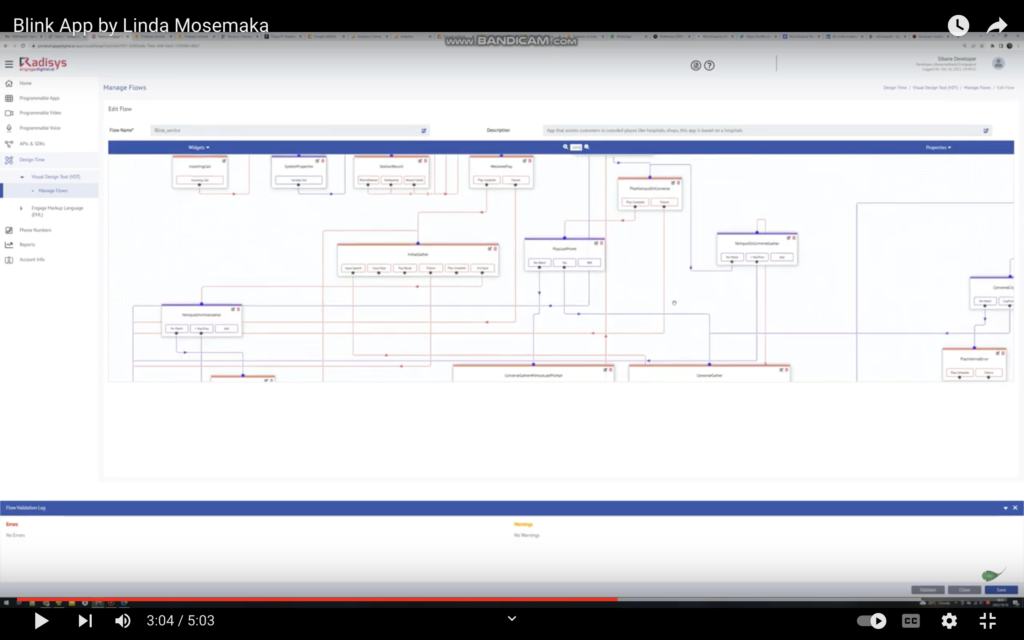The purpose of this CXTech Week 33 2024 newsletter is to highlight, with commentary, some of the news stories in CXTech this week. What is CXTech? The C stands for Connectivity, Communications, Collaboration, Conversation, Customer; X for Experience because that’s what matters; and Tech because the focus is enablers.
You can sign up here to receive the CXTech News and Analysis by email or by my Substack. Please forward this on if you think someone should join the list. And please let me know any CXTech news I should include.
Covered this week:
- Are leaders ready for the telco of tomorrow?
- The Definitive Truth in A2P SMS
- Podcast 84: Truth in AI, Paul Golding
- TADHack South Africa Memories
- Jambonz now integrates with Microsoft Teams as a Direct Routing SBC
- Another year, another Chenosis refresh?
- People, Gossip, and Frivolous Stuff
Are leaders ready for the telco of tomorrow?

This report is simply to sell EY’s strategic consulting services.
But that’s irrelevant to the point I want to make. Why are PSTN voice, messaging, and emergency services are not mentioned throughout the report? In 5 years time I guarantee these services will be there, the question is whether they remain in some cases a national embarrassment?
I assume this report is covering fixed only, mobile only, and converged telcos. The Classic Big Telco mentioned in the report is likely the old monopoly that generally has fixed, mobile, enterprise, and wholesale divisions.
From a consumer perspective, Internet Access is the service we use most. But the bundled voice, SMS and emergency service are definitely important and used everyday.
In some countries, robocalling and spam SMS have degraded the PSTN to the point people generally do not answer my phone. Last week about half my calls were ‘spam likely’. The elderly who answer the phone or SMS regardless are being defrauded on a massive scale, its tens of billions in total.
I covered the fraud over (Application to Person) A2P SMS in this article, https://blog.tadsummit.com/2024/08/12/definitive-truth-in-a2p-sms/, the situation is so bad businesses are reverting to email, and migrating to IP messaging. PSTN services appear to be left to die on the vine in some countries.
Businesses have moved from traditional telco provided enterprise voice and conferencing to providers like RingCentral, Teams, and Zoom that offer highly integrated solutions with enterprise workflows and platforms. RingCentral partners with telcos as a channel, and serves enterprises direct. There are plain vanilla solutions focused on SMB (Small Medium Business) though local technology integrators. Telecoms networks are now software with low capacity flows of a few tens of kbit/s over the internet, or enterprise network, or even the PSTN when the channel is the telco.
Will the same happen in consumer? With my consumer hat on, SMS, WhatsApp, and good old PSTN voice are the ones I use, along with my neighbors, local businesses, even my son will very occasionally, when I didn’t respond to his text, use PSTN voice. It’s not going away, even though my son’s telephone etiquette is stunted.
Telcos will for the foreseeable future continue to deliver internet access and PSTN services. Why is such a core and long term element of a telcos’ strategy unstated? PSTN today has nothing to do with the network. Whether AWS or Microsoft is a competitor or supplier is mute, it’s both, and that situation is not going to change. Telcos role there is being a sovereign cloud provider / data center, like DT’s programmable communications offer that won VirtualQ from Twilio. But the cloud providers will get there in sovereign clouds, it’s just a matter of market size and time.
Back to the PSTN. SMS needs telcos to take back control, investment is required, as discussed here, https://blog.tadsummit.com/2024/08/12/definitive-truth-in-a2p-sms/. Yes, it’s a patchwork quilt of solutions, with a couple of small companies. However, disruptive innovation tends not to come from large strategic vendors.
PSTN voice is complex, the move to HD PSTN voice I think is complete. But the variety of handsets, networks, and configurations means we’re simply tolerant of a range of qualities. It works and is good enough.
PSTN Voice is a massive market over $500B, depending on how you measure it. International is tiny as we use WhatsApp, FaceTime, and all the other IP comms services. Communications is and will remain heterogeneous. Phone numbers have not gone away. When I buy my holiday roaming package, unlimited voice and messaging should be included because it should be IP.
Emergency PSTN services should be marketed, so customers understand the services provided. The last time I used 911 was about 20 years ago when my car broke down on a highway, and I was instructed to call 911 as the AAA could not pick up from there. There’s emergency SMS, important in abuse situations, none of my neighbors know about that emergency service. And yes, one of my neighbors was an abuser. The neighbors on my street use 911 about once a year for illnesses, grills on fire, deer or bear incidents, flooding, disputes; it’s surprisingly common. One neighbor got into a dispute with a contractor last month and they both called the police. Yes, this is America.
PSTN remains important despite robocalling and spam SMS that now make it an appalling service in the US, and some parts of Africa, Central and South America. I’ve never known it to be so bad. It’s a future and today problem, as the PSTN is not going away. So back to the article on “Are leaders ready for the telco of tomorrow?” They need to care about the telco of today first, and fix the PSTN, as it’s not going away despite what appears a concerted effort in some countries to drive customers away.
The Definitive Truth in A2P SMS

This series of articles had so far over 20k unique views. The feedback has been excellent from A leader (Robert Vis) in the A2P SMS industry, from customers in industries like banking, and many from the industry.
Implementing Augnet, publishing and harmonizing SMS rates, implementing A2P SMS revenue assurance, closing down the SIM Farms once and for all using Wadaro, and copying carriers like BT take back control over the service their customers are paying them for (SMS) seem straightforward.
Things the industry could do to begin the process of restoring trust. We still have the core problem of SS7, but if we make A2P SMS fraud much more difficult, the crooks may start to look at easier targets.
Specific, quantified, and direct action is the only way to stop the rot. If action does not take place, I’ll be writing an epitaph on how the tragedy of the commons killed SMS. And in reference to the above article “Are leaders ready for the telco of tomorrow?” The answer is NO because the PSTN is on fire and only a few telcos are doing something about it.
Podcast 84: Truth in AI, Paul Golding
I’ve known Paul Golding for many years, well over one decade. All the way back to the early days of helping telcos try to understand what are these things called “developers”. Paul has been in AI since the beginning, I recommend following Paul as his posts are insightful and an excellent tracker on the latest in AI.
For example, just before we hopped onto the podcast Paul had posted on LLM evaluation tools and their importance in confirming the LLM does only what you intend, it’s a hard problem, much harder than software testing.
Through the podcast you’ll learn of the shortcomings of LLMs and some of the additional steps and technologies required to get close to the hype we currently experienced. This is a long podcast, but its deep and you’ll learn a lot. We really have taken a first step, of a thousand mile journey. That realization, AI is not a quick win, kicked off a stock market correction this week. Remember when governments were talking about the strategic importance of 6G, that one’s gone quiet. However, AI is different to 6G it is important. Casey Newton did a nice post setting the market correction in context, AI takes time.
Paul reviews the noise, and we’ve been here before, many times, with blockchain, big data, machine learning, dot com, wireless web, gamification, AR/VR, Metaverses, etc. All of which delivered to varying degrees, but it takes time, we have to experiment and learn, and that learning time varies.
Paul posits the co-incidence of foundation models like OpenAI working in a form, and lots of research papers with claims on massive performance improvements created a productivity myth. Such as coders can be 400% more efficient with a coding co-pilot, sales people can double their quota with an assistant. The market seems on the fence about co-pilots at the moment, with Github’s copilot receiving the most positive mixed reviews.
Clearly the hype has proven to be just that. And we’re currently in a phase of testing and experimentation. The more training the LLM receives the more general the answers. Its an inference engine and its seeing lots of answers, so the answers become more general to cover everything it’s seen. We see that in Chat GPT, the suggested text is bland and so generic to be almost meaningless.
While Chat GPT delivers the experience of an engaged discussion its not delivering insight. Its at risk of being too general. That’s where in combination with machine learning, e.g. XGBoost (decision tree machine learning library started in 2014), insight with orchestration is possible.
This is interesting, LLMs are a neat front end, but it’s often generic and bland. While in combination with machine learning / data science, the identification and application of rare insights could be possible.
The missing discipline across all this is the evaluation models to ensure LLM/ML combination does what is required.
So the 3 steps are, using weak supervision build many recipes / models, assemble into a strong learner using machine learning, and evaluate the combination.
Johnny wants to do a review with Paul of some of the companies with AI stories doing the rounds on Wall Street. We’ll have Paul back soon for that.
TADHack South Africa Memories
I had a previous TADHack winner, Linda mosemaka asking for help in finding projects, check out his resume / CV, and please offer him advice, thank you. https://blog.tadhack.com/2024/08/13/linda-percy-mosemaka/
I also had Talhah Patelia thanking me for all we did at TADHack South Africa, that allowed him to settle in the innovation space. Check out his winning hack Maftuha built on Telnyx, Tata Consultancy Services, Symbl.ai, and ayoba, https://blog.tadhack.com/2021/10/14/tadhack-south-africa-winner-maftuha/
Lovely memories and making a difference in people’s lives 🙂

Jambonz now integrates with Microsoft Teams as a Direct Routing SBC
Did you know that jambonz can seamlessly integrate with Microsoft Teams as a Direct Routing SBC? This powerful feature is exclusively available for self-hosted versions of jambonz, providing even more flexibility for those looking to control their own voice infrastructure.
Setting up a Direct Routing SBC on the Teams side has traditionally been a challenging process, but we’ve got you covered! Thanks to the efforts of two jambonz customers – Peter Mijnster at Sound of Data and Antony Jukes at Callable – who have collaborated to write a blog post that walks you through the process of setting up jambonz as a Direct Routing SBC for MS Teams.
If you’re running jambonz on your own infrastructure and want to integrate Teams calling, this is a must-read. Check out their blog post: https://blog.jambonz.org/microsoft-teams-direct-routing-with-jambonz.
Another year, another Chenosis refresh?
Back in 2023 Chenosis did a relaunch, I reviewed it here. I saw this TECHCENTRAL article from a couple of days ago that looks like a refresh.
Chenosis is an API Marketplace / platform, first announced in 2020. The focus for 2024 appears to be AI with multiple languages supported by Botlhale’s LLM including Afrikaans, isiZulu and Sesotho. Chenosis supports other services such as KYC (“know your customer”) verification tools to fraud detection, payments processing and access control.
Chenosis is built with Apigee, there’s a long history going back to before Google bought them. Here’s an article explaining how Apigee is only API management. It does not contain a telecom app server to support communication services. They’ve not expanded beyond SMS on the telecoms side, rather focused on identity and payments.
The advice I provided in 2020 was to focus on a couple of viable businesses, and build the MVP (Minimum Viable Product) for each business in one country. For example, undercut the aggregators for messaging. We’ve seen telcos in the Middle East start to do this in 2021 and have become successful. Telcos control their wholesale pricing and costs for A2P SMS, they have an in-country competitive advantage compared to the aggregators.
Another opportunity is sovereign customer data, we’ve seen DT be successful there in winning a Twilio customer NetworkQ. Though we’ll see the cloud providers build out sovereign data centers depending on the addressable market size and timing.
Another opportunity in Africa is with respect to trust, specifically identity verification (e.g. silent network verification to confirm its Alan’s phone) or credit risk rating using insight such as Alan has been a MTN postpaid customer at the same address with XYZ geodemographic profile for 15 years. Chenosis has focused there.
Ayoba and Momo are two well-established MTN brands, and have worked with TADHack over the years. Ayoba is an all-in-one App focused on the needs of the African market. They have sponsored TADHack and some amazing apps have been created over the years, for example Maftuha, by Adela Bootha and Talhah Patelia. The power of Ayoba is it provides distribution for applications, like Google Play and the Apple App Store. MoMo is a mobile money wallet API/app, and again a TADHack sponsor, check out Xplorer by Naomi Skie (@NaomiBisimwa), Carol Khoza (@karol_khoza), and Christine Bismwa (@Hyitschristine).
The claims of Chenosis becoming a marketplace and accelerator are tough because MTN is not a technology company like AWS, Azure, or Google; which makes them all developer-centric. MTN is an operations company, it is not developer centric. It works best in B2B relationships with scale where through its network and operations has defensible value. Other telcos have realized that.
In talking with some of the brands that have talked with Chenosis, the value of going via Chenosis rather than direct is unclear. In the beginning API directories had value, but even Programmable Web closed down in 2023. Developers are so much more sophisticated, they chat, have discussion groups, and meet at regular hackathons and meet ups. They are constantly sharing insights on new services and their firsthand experiences. The benefit of a marketplace is unclear, when going direct is easier and potentially cheaper.
People, Gossip, and Frivolous Stuff
Anant Kumar is now EVP Engineering and CIO Digital at airtel. I’ve known Anant throughout his time in airtel.
Piyumi Gunasekera is now Accountant at Scalable Hosting Solutions OÜ.I’ve known Piyumi since she was a student over one decade ago.
Michael Hays is now Staff Product Manager at DISH Network Technologies. I’ve known Michael for over a decade, since his time at CenturyLink.
Dieter Hovorka is now Partner & General Manager at AR74 Global.
Angela Tobar is now Sales Consultant at Cari AI.
Reed Majors is now Director Partnerships, Channel North America, IOT Connected Services at Semtech. I’ve known Reed since his FutureDial days.
Linda (Percy) Mosemaka. Seeking full-time or project work.

You can sign up here to receive the CXTech News and Analysis by email or by my Substack.